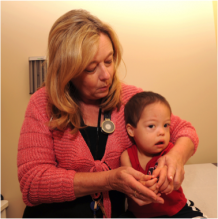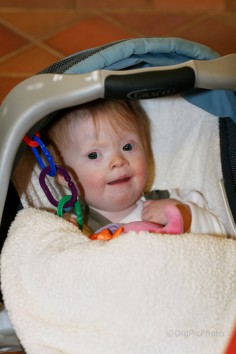Infantile Spasms in Children with Down Syndrome: Investigating a Rare but Serious Condition
Infantile spasms can occur in children with Down syndrome and typical children alike. Ongoing research at the Anna and John J. Sie Center for Down Syndrome at Children’s Hospital Colorado examines the relationship between infantile spasms and Down syndrome in hopes of improving diagnosis and treatment.
 The spasms, characterized by a stiffening of the extremities and an arching or folding at the waist, are also known as West’s syndrome after the first known description of the condition’s symptoms — a letter penned by Dr. W. J. West describing his son’s attacks. Dr. West’s son would heave forward from the waist for a moment, then return to an upright position. These episodes would occur in clusters of as many as 20 spasms in a row in rapid succession.
The spasms, characterized by a stiffening of the extremities and an arching or folding at the waist, are also known as West’s syndrome after the first known description of the condition’s symptoms — a letter penned by Dr. W. J. West describing his son’s attacks. Dr. West’s son would heave forward from the waist for a moment, then return to an upright position. These episodes would occur in clusters of as many as 20 spasms in a row in rapid succession.
While infantile spasms are serious, they are not common. Estimates suggest 1 to 3 percent of children with Down syndrome will develop infantile spasms, while the highest estimate places that figure around 13 percent.
Why So Serious?
Children with infantile spasms stop progressing toward developmental milestones and may lose motor skills they have already mastered, such as sitting up or crawling. They may experience cognitive and speech regression as well.
Unaddressed infantile spasms may permanently impair functionality and impact children’s abilities — a serious concern for children with Down syndrome who may already have developmental delays.
“It is imperative to diagnose infantile spasms early to promote early appropriate treatment and the best possible outcome,” said Dee Daniels, R.N., C.P.N.P., Program Director at the Sie Center.
The Infantile Spasms Research Study


Dee Daniels & Dr. Tim Benke
Currently, the most effective treatments for infantile spasms are pharmaceutical.
“Once, working with children who have Down syndrome and infantile spasms, I noticed that children with Down syndrome were more responsive to treatment, and many times, their infantile spasms resolved quickly,” said Daniels, who was previously a nurse practitioner on the epilepsy team in neurology at Children’s Hospital Colorado. “They also often did not go on to have other seizure types, which was not always the case in typical children who had infantile spasms.”
In the first phase of the Improved Outcome of Infantile Seizures in Down Syndrome Population research project, researchers at the Sie Center are examining the records of 28 patients with Down syndrome and infantile spasms who were cared for at Children’s Hospital Colorado between April 2005 and April 2013. Thus far, researchers have examined the response to various anticonvulsants — including adrenocorticotropic hormone (ACTH) and vigabatrin — to determine their effectiveness.
The research is planned to continue as a 10-year longitudinal study.
“While ACTH treatment for infantile spasms is effective, it can be potentially costly and time consuming. Each type of treatment, ACTH or vigabatrin, has unique side effects,” said Tim Benke, M.D., Ph.D., Director of Research at the Neuroscience Institute at Children’s Hospital Colorado, and Associate Professor of Pediatrics, Neurology, Otolaryngology, and Pharmacology at the University of Colorado School of Medicine. “We want to provide clear information and guidelines for families so they can make informed decisions about what’s right for their children.”
Spotting the Signs
 Daniels and Dr. Benke also hope this research will help to increase awareness of infantile spasms in children with Down syndrome, so those who are experiencing this condition will be identified early and treated appropriately to improve their medical and developmental outcomes.
Daniels and Dr. Benke also hope this research will help to increase awareness of infantile spasms in children with Down syndrome, so those who are experiencing this condition will be identified early and treated appropriately to improve their medical and developmental outcomes.
“Sometimes children with Down syndrome who are experiencing infantile spasms are not always recognized early and then treatment is delayed,” Daniels said. “Contributing factors to this missed diagnosis can be that children with Down syndrome already have a range of development delays prior to diagnosis as well as low muscle tone and other medical issues. Subtle early symptoms are often attributed to Down syndrome, hence the diagnosis of infantile spasms is delayed or missed. Raising the awareness of the child’s healthcare providers, parents, and caretakers about the risk and presenting features of infantile spasms in children with Down syndrome is imperative to improving outcomes.”
The Sie Center was founded in 2010 with the support of the Global Down Syndrome Foundation. It serves as a hub of care and research for children with Down syndrome and has the added benefit of being connected to Children’s Hospital Colorado, a top 10 children’s hospital. For more information about the work being done at the Sie Center, visit siecenter.org.
Recent Posts
- GLOBAL LEADERS – An Exclusive Interview with Erin Suelmann, Executive Director of the Down Syndrome Association of Greater St. Louis
- Sleep Apnea Across the Lifespan in People with Down Syndrome
- Government Profiles: Robert Aderholt (R-AL) & Tammy Baldwin (D-WI)
- Connor Long & Josh Peck: A GLOBAL Bromance
- GLOBAL Launches Pilot Fitness Program using Mann Method PT

 Experience our inspirational and groundbreaking videos and photos. Our children and self-advocates are beautiful AND brilliant!
Experience our inspirational and groundbreaking videos and photos. Our children and self-advocates are beautiful AND brilliant! Make sure your local Representatives are on the Congressional Down Syndrome Task Force.
Make sure your local Representatives are on the Congressional Down Syndrome Task Force.